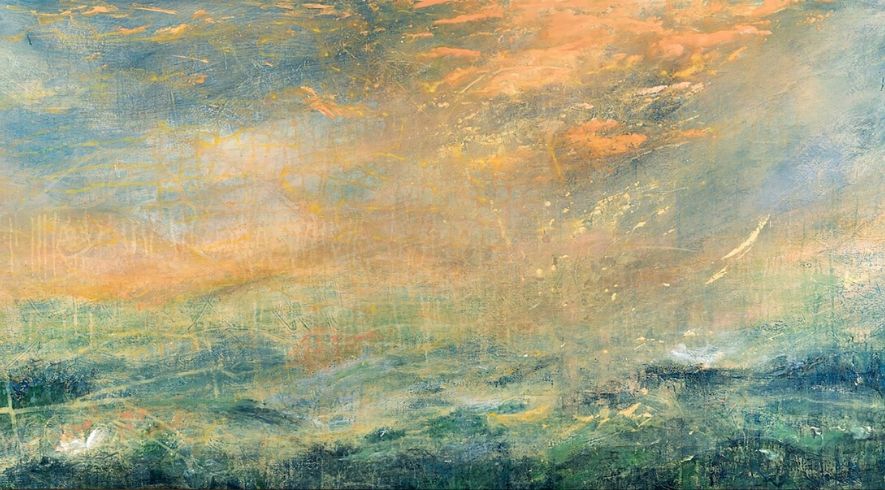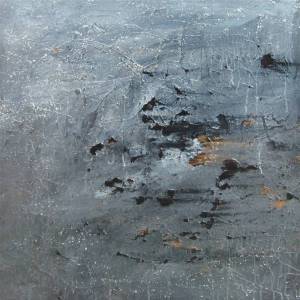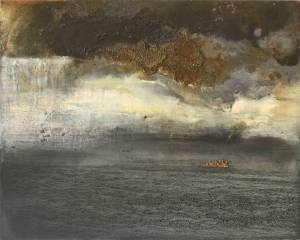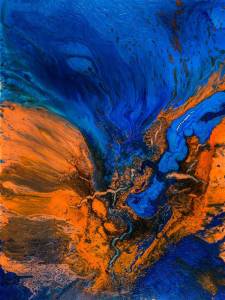Have you ever stood in front of a painting, taken by its visual power and yet absolutely bewildered by its meaning? Is it a giant snowy mountain shining brightly under the sunlight, or is it an intimidating volcano bursting through the sky? Is it even supposed to be anything? If questions like these have ever crossed your mind while viewing a work, you're in the right place.

The Magic Hour, Acrylic on Canvas, by Rebecca Katz
What is abstract art? Here, we discuss how to understand it and comprehend the artist's intention. By appreciating the art form for the freedom it inspires in making individual visual connections, we're attempting to navigate every step toward understanding abstraction.
Let's Begin?
Understanding abstract art is fairly easy -
all you need is an open mind and a wandering imagination. The first step is to
prepare yourself to look beyond the things you already know or recognize.
Abstraction finds its roots in 'intuition' (of the artist) and 'freedom' (for the artist as well as for the viewer). It is the capability of the artist to use their imagination to look beyond what we can physically see and translate intangible emotions onto the canvas. It is also the ability of the audience to then try to connect to the artist's intention and free their own mind of visual restrictions. Historically, the abstract art movement emerged in the nineteenth century as a reaction to academic painting or realism. In fact, a very simple way to understand the essence of abstract art is to think of it as a visual opposite of realistic art. While realism pays attention to every tiny fold or wrinkle, abstraction gives the artist the freedom to trust their intuition to create art that is equally worthy of an audience.

2012.VII.16, Acrylic & amp; Mixed Media on Wood Panel by Anina E. Hathaway
There is No Code to Crack
As human beings, solving problems comes
naturally to us. While this can be quite useful in most situations, it isn't so
in the case of abstract art.
The most important thing to understand about
abstract art is that it does NOT have to have a meaning, narrative or even a
singular explanation.
The main purpose of abstraction is not to tell
a story, but to encourage involvement and imagination. This art form is mostly
about providing its viewers with an intangible and emotional experience - more
often than not, the experience is completely different for every individual
depending on their personality and state of mind.
Therefore, it is really up to the viewer to
decide whether the painting in front of them has any meaning or provokes any
emotion. As we mentioned, abstract art is all about freedom.
How to Look at Abstract Art
So, how do you actually look at it and
understand it? Do you stand in front of it and try to find familiar figures or
do you just glance at it in passing?
Realizing that there are different ways to approach and criticize art is important when attempting to understand abstraction. It is easy to appreciate a Van Gogh or a Rembrandt, as the mastery of technique is visible. However, in order to appreciate abstraction, our focus should not be on how realistically the artist has painted something or someone but rather on how successful a piece is in evoking emotion.

Anxiety, Oil on Birch Panel by Marina Maltezou
Abstract paintings can also be appreciated in
terms of the individual elements of art: color, shape, line, texture, space,
value, etc. An abstract artist's skills lie in his or her ability to use colors
and textures to their best visual strength and to create a sound composition
from these elements.
Here are some dos and don'ts to keep in mind:
Don't look at the clock. There is no need to stand in front of
an abstract work for hours to really understand it. Look at it for as long as
you want, and for as long as it pulls you in.
Don't talk about your five-year-old. We all know art is subjective, and
sometimes there are pieces that we just can't connect to, especially when it
comes to abstract art. Nonetheless, your five-year-old can still not do that.
Don't insult the artist's imagination. Instead, if you really can't seem to
like a work, think about what it is that makes you feel that way.
Don't mind the title. More often than not, abstract paintings
will have an extremely vague title, like Number 4 or Black and
Red. Don't let that bother you. Most artists purposely don't use giveaway
titles because they want you to interact with the art and eventually find your
own meaning. On the other hand, you don't have to completely ignore the title;
sometimes, they can be very helpful in guiding your imagination.
Do read the wall text. Speaking of guides, always read the wall text. It can give you valuable information on the artist's background or artistic intention.

Untitled 15, Acrylic & amp; Beads on Canvas by Casar Rodriguez
Do let the painting reach out to you. Free your mind of any other thoughts,
give it a little time and simply let the painting convey its intended emotion
to you. Observe the colors and textures. What do they make you feel? Jackson
Pollock said, "Abstract painting is abstract. It confronts you." Let the
painting ask the questions instead of the other way around.
Don't stress about feeling something. It is not necessary for an abstract
painting to have a contextual side to it, and it is not necessary for you to be
able to feel each and every emotion it is meant to convey. If it doesn't do
anything for you, so be it.
Don't ask all of the questions just yet. Thinking too much about what the
painting means can be disturbing or tiring. Instead, focus on how the painting
makes you feel and what kind of emotions it conveys to you. Think about how the
artist's background or situation may have affected his painting. Try to work
with the things you know, instead of questioning everything.
Do remember that abstraction does not have to have a meaning. While "getting" an artwork brings a momentary feeling of victory, bathing in its mystery brings enjoyment for far longer.
www.art-mine.com, 2019